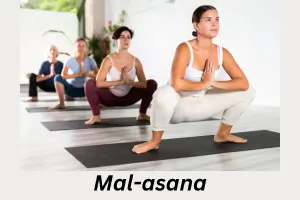Introduction
Malasana, also known as the Garland Pose, is a deep squat posture that is commonly practiced in yoga to open the hips and stretch the lower back.
This pose is highly beneficial for improving flexibility, balance, and digestion.
Traditionally, Malasana has been considered a grounding and centering pose that allows practitioners to connect deeply with their body’s foundation and root chakra.

The simplicity of the pose makes it accessible to beginners, but it still offers a deep stretch and release for more experienced yogis.
Malasana is ideal for promoting mobility in the hips, knees, and ankles, which can become tight due to prolonged sitting or inactivity.
Steps to Perform Malasana Yoga Pose (Garland Pose)
- Begin in a Standing Position:
Start by standing at the top of your mat with your feet slightly wider than hip-distance apart. Make sure your toes are pointed slightly outward, about 45 degrees, as this will help facilitate the deep squat. - Bend Your Knees into a Squat:
Slowly bend your knees and lower your hips down towards the floor, coming into a deep squat. Try to keep your heels on the floor, although it’s okay if they lift slightly as you work toward more flexibility. - Bring Hands into Prayer Position (Anjali Mudra):
As you squat, bring your palms together at your heart center in a prayer position (Anjali Mudra). Press your elbows gently into the inner sides of your knees to help widen them. This will also deepen the stretch in your hips and groin. - Lengthen the Spine:
Keep your spine long by lifting your chest and elongating through the crown of your head. Avoid rounding your back, and engage your core muscles to support your posture. Your gaze should be straight ahead or slightly upward. - Hold and Breathe:
Hold the pose for 30 seconds to a minute, breathing deeply and steadily. Focus on expanding your hips and maintaining balance. With each exhale, allow your hips to sink lower as your body relaxes into the posture. - Release the Pose:
To come out of the pose, press into your feet and slowly straighten your legs, rising back to a standing position. Take a moment to shake out your legs and feet, releasing any tension that may have accumulated during the pose.
Benefits of Malasana Yoga Pose (Garland Pose)
- Improves Hip Flexibility:
Malasana is one of the best poses for stretching and opening up the hips. It provides deep external rotation and loosening of the hip joints, which can improve overall hip mobility. Regular practice can alleviate tightness in the hips caused by prolonged sitting. - Strengthens the Lower Body:
This squat pose engages and strengthens the muscles in the legs, particularly the quadriceps, hamstrings, calves, and glutes. It also strengthens the core muscles as you work to stabilize and balance in the squat position. - Promotes Healthy Digestion:
The deep squatting action of Malasana stimulates the digestive organs, including the intestines, helping to improve digestion and relieve constipation. The pose is said to activate the digestive fire (Agni) and enhance the body’s ability to process and eliminate waste. - Enhances Balance and Stability:
Holding the squat position in Malasana challenges your balance and coordination. The pose requires you to engage your core and lower body to maintain stability, improving overall body control and balance. - Stretches the Lower Back:
By lengthening the spine and opening up the lower back, Malasana provides relief from tension and stiffness in this area. It can be especially beneficial for individuals who experience lower back pain due to sitting or improper posture. - Encourages Grounding and Focus:
Malasana is considered a grounding pose that helps you feel more connected to the earth. It can promote mental clarity and emotional stability, making it a great pose for reducing stress and calming the mind. - Opens the Pelvic Floor:
For women, Malasana can be beneficial in strengthening and opening the pelvic floor muscles, which may support reproductive health. It is often recommended during prenatal yoga for its ability to open the hips and prepare the body for childbirth. - Increases Ankle and Knee Mobility:
The deep squat position places a gentle stretch on the ankle and knee joints, improving flexibility and mobility in these areas. Over time, this can enhance your ability to perform other poses and movements that require ankle and knee strength.
Precautions and Contraindications for Malasana Yoga Pose (Garland Pose)
- Knee Injuries:
Individuals with knee injuries or weakness should approach Malasana with caution, as the deep squatting position places pressure on the knees. Modifications such as using a folded blanket or yoga block under the heels may help reduce discomfort. - Ankle or Achilles Tendon Issues:
Those with tight ankles or Achilles tendon injuries may find it difficult to keep their heels on the floor in this pose. To alleviate strain, consider placing a rolled-up towel or yoga block under the heels for support. - Lower Back Problems:
Practitioners with lower back pain or disc issues should be mindful of maintaining a straight spine and engaging the core during the pose. If discomfort arises, it may be necessary to modify or avoid the pose altogether. - Pregnancy:
While Malasana can be beneficial during pregnancy, it’s important for pregnant women to avoid overstraining and to listen to their bodies. Using props such as blocks for support can help make the pose safer and more comfortable. - Balance Concerns:
If you have difficulty with balance, consider practicing Malasana near a wall or using a chair for stability. You can hold onto the chair or wall as you lower yourself into the squat to ensure a safe practice. - Avoid Excessive Force:
While it’s tempting to push the knees further apart in the pose, avoid applying too much force, especially in the hips and knees. Overstretching can lead to strain or injury. Focus on breathing deeply and gradually deepening the stretch over time. - Breathing Restrictions:
Since Malasana requires a deep squatting position, some individuals may find it difficult to breathe fully in this posture. It’s important to maintain steady, mindful breathing throughout the pose and to come out of the posture if you feel lightheaded or restricted.
Conclusion
- Malasana is a powerful and transformative yoga pose that offers a variety of physical, mental, and emotional benefits.
- As a deep squat that engages the lower body, Malasana is ideal for promoting flexibility, balance, and stability, while also helping to release tension in the hips, lower back, and legs.
- In addition to its physical benefits, Malasana can have a profound grounding effect, fostering a sense of connectedness to the earth and calming the mind.
- Regular practice of this pose can improve overall mobility and posture, making it an essential part of any yoga routine.
- Moreover, Malasana’s ability to stimulate digestion and balance energy makes it a valuable tool for enhancing overall well-being.
- With its combination of physical engagement and mental focus, Malasana is a simple yet highly effective pose that can be integrated into various yoga practices.
- Whether you’re seeking to increase flexibility, improve digestive health, or find mental clarity, the Garland Pose offers a holistic approach to wellness.
- As with all yoga poses, the key to success lies in patience, practice, and mindfulness. With time, Malasana can become a gateway to deeper understanding and connection within your yoga practice.
